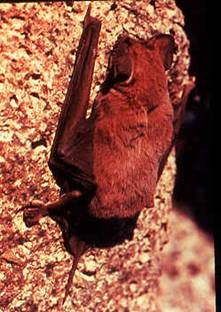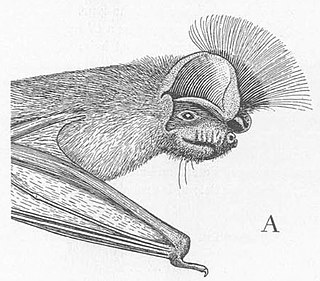
Vespertilionidae is a family of microbats, of the order Chiroptera, flying, insect-eating mammals variously described as the common, vesper, or simple nosed bats. The vespertilionid family is the most diverse and widely distributed of bat families, specialised in many forms to occupy a range of habitats and ecological circumstances, and it is frequently observed or the subject of research. The facial features of the species are often simple, as they mainly rely on vocally emitted echolocation. The tails of the species are enclosed by the lower flight membranes between the legs. Over 300 species are distributed all over the world, on every continent except Antarctica. It owes its name to the genus Vespertilio, which takes its name from a word for bat, vespertilio, derived from the Latin term vesper meaning 'evening'; they are termed "evening bats" and were once referred to as "evening birds".

The Molossidae, or free-tailed bats, are a family of bats within the order Chiroptera. The Molossidae is the fourth-largest family of bats, containing about 110 species as of 2012. They are generally quite robust, and consist of many strong-flying forms with relatively long and narrow wings with wrinkled lips shared through their genus. Their strong flying form allows them to fly 60 miles per hour using tail winds and at altitudes over 10,000 feet. This makes them unique among bats, as they are the only bat family that withstands the elevation. They are widespread, being found on every continent except Antarctica. They are typically found in caves, abandoned mines, or tunnels.

The Mexican free-tailed bat or Brazilian free-tailed bat is a medium-sized bat native to the Americas, regarded as one of the most abundant mammals in North America. Its proclivity towards roosting in huge numbers at relatively few locations makes it vulnerable to habitat destruction in spite of its abundance. It has been claimed to have the fastest horizontal speed of any animal, reaching top ground speeds over 101 mph (162 km/h); its actual air speed has not been measured. The Texas Legislature designated the Mexican free-tailed bat the state mammal (flying) in 1995.

The dwarf dog-faced bat is a species of free-tailed bat from South America. It is found in Argentina, Bolivia, Brazil, Colombia, Ecuador, Guyana, Peru, Paraguay and Uruguay, typically at lower elevations. It is one of two species in the genus Molossops, the other being the rufous dog-faced bat. Three subspecies are often recognized, though mammalogist Judith Eger considers it monotypic with no subspecies. It is a small free-tailed bat, with a forearm length of 28.9–32.5 mm (1.14–1.28 in) and a weight of 5–8 g (0.18–0.28 oz); males are larger than females. It is brown, with paler belly fur and darker back fur. Its wings are unusual for a free-tailed bat, with exceptionally broad wingtips. Additionally, it has low wing loading, meaning that it has a large wing surface area relative to its body weight. Therefore, it flies more similarly to a vesper bat than to other species in its own family. As it forages at night for its insect prey, including moths, beetles, and others, it uses two kinds of frequency-modulated echolocation calls: one type is to navigate in open areas and to search for prey, while the other type is used for navigating in cluttered areas or while approaching a prey item.
The northern freetail bat is a species of bat found in Yapen, Seram Island, Western New Guinea and Northern Australia.
The variegated butterfly bat is a species of vesper bat. It is sometimes also called the leaf-winged bat, or simply the butterfly bat. It is not currently endangered, but may be threatened by habitat loss in some parts of its range.

Chapin's free-tailed bat is a species of bat in the family Molossidae. It is found in central and southern Africa.

The Nigerian free-tailed bat is a species of bat in the family Molossidae. It is native to two widely separated parts of Africa, and is sometimes considered to represent two separate species.

The little free-tailed bat is a species of the genus Chaerephon in the family Molossidae. It is widely distributed across Africa and islands around the continent.

The hairless bat, also called the naked bulldog bat and greater naked bat, is a species of bat in the family Molossidae. The generic name Cheiromeles comes from the Greek word cheir and the species name is derived from the Latin torques.

The Angolan free-tailed bat is a species of bat in the family Molossidae. It is found in Angola, Benin, Botswana, Burkina Faso, Burundi, Cameroon, the Republic of the Congo, the Democratic Republic of the Congo, Ivory Coast, Eswatini, Ethiopia, Gambia, Ghana, Guinea, Kenya, Malawi, Mali, Mozambique, Namibia, Niger, Nigeria, Rwanda, Senegal, Sierra Leone, Somalia, South Africa, South Sudan, Sudan, Tanzania, Togo, Uganda, Zambia, and Zimbabwe. Its natural habitats are dry and moist savanna, although it is sometimes found at the edges of woodlands.

The Mongalla free-tailed bat is a species of bat in the family Molossidae. It is found in Burkina Faso, Cameroon, Democratic Republic of the Congo, Ivory Coast, Ghana, Kenya, Mali, Sudan, and Uganda. Its natural habitats are dry savanna, moist savanna, and subtropical or tropical seasonally wet or flooded lowland grassland. It is threatened by habitat loss.

The Midas free-tailed bat is a species of bat scientifically classified in the order Chiroptera and the family Molossidae. It is distributed from western Africa to Saudi Arabia and further south. Its natural habitats are dry savanna, moist savanna, woodlands and hot deserts. The more southern are also known to live around large rivers or the swamps. It is threatened by habitat loss.
Roberts's flat-headed bat is a species of free-tailed bat native to southern Africa. It is the only species in the genus Sauromys. The scientific name translates as "rock loving lizard-mouse", while the common name honours Austin Roberts, who first described the species.

The Egyptian free-tailed bat, also known as Egyptian guano bat or Egyptian nyctinome, is a species of bat in the family Molossidae.

The white-striped free-tailed bat is a species of bat in the family Molossidae. Its echolocation calls are audible to humans, which is a characteristic found in only a few microbat species. The species was formerly classified as Tadarida australis.

Chaerephon is a genus of Old World free-tailed bats in the family Molossidae. Molecular sequence data indicates that Chaerephon, Mops and Tadarida are not monophyletic taxa. The closest relatives of Chaerephon jobimena of Madagascar are Tadarida aegyptiaca of Africa and southwest Asia, and Tadarida brasiliensis of the Americas, which form a clade believed to be about 9.8 million years old. However, the grouping of Chaerephon minus C. jobimena plus Mops was found to be monophyletic.

Gallagher's free-tailed bat is a free-tailed bat endemic to the Democratic Republic of the Congo. Only one individual has ever been documented.

Chaerephon jobimena, commonly known as the black and red free-tailed bat, is a species of bat in the family Molossidae. It is endemic to western Madagascar. With a forearm length of 45 to 48 mm, C. jobimena is somewhat larger than other Malagasy bats assigned to Chaerephon, but similar in size to Tadarida aegyptiaca.
Chaerephon atsinanana is a free-tailed bat found on Madagascar. It was considered a subspecies of the little free-tailed bat until 2010. During the day, they are known to roost in man-made structures such as the roofs or attics of buildings.

















